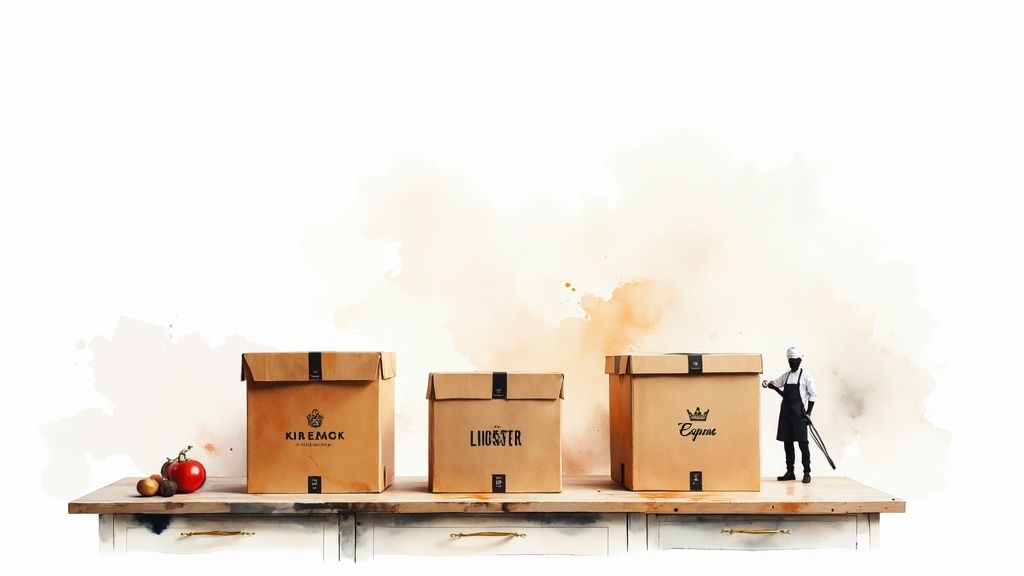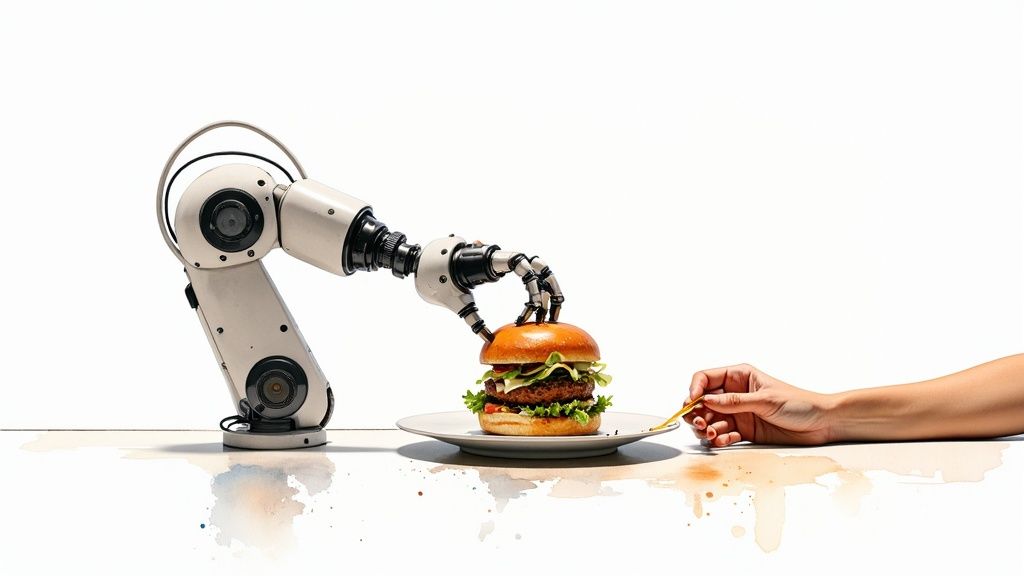Stay competitive with the top restaurant technology trends to boost efficiency and cut costs

Running a restaurant means juggling staff, food costs, and guest satisfaction. You don't have time for every new gadget. But some technology is now essential to stay competitive. Ignoring key shifts can put you behind, while the wrong tech drains your thin margins.
We've cut through the noise to focus on the restaurant technology trends delivering real ROI. This isn't a list of futuristic concepts; it’s a practical guide to tools that streamline operations, reduce waste, and help you make smarter decisions. Think of this as your shortlist for tech that solves the daily challenges you face, from the front of house to the back.
AI is no longer just for chains. Modern systems analyze past orders to suggest menu items, automate upselling, and create targeted promotions that resonate with individual guests. The goal is to increase average check size and build loyalty by predicting what a customer wants. An example is AI-powered vending solutions, which show how machine learning can streamline sales.

Ghost kitchens are delivery-only concepts without a storefront, leveraging delivery apps to reach customers. This model slashes overhead costs like rent and front-of-house staff. Operations are streamlined for pure production, allowing operators to launch multiple virtual brands from a single kitchen with minimal financial risk.

Contactless payment is now a customer expectation. This includes tap-to-pay cards, mobile wallets like Apple Pay, and QR code systems. It’s no longer just a convenience; it speeds up checkout, reduces contact, and improves service efficiency. Faster payment processing means quicker table turns during peak hours and a streamlined workflow for staff. To see how this works, learn how contactless payment is enhancing the customer experience.
A Kitchen Display System (KDS) replaces paper tickets with screens that display orders in real-time. This connects the front of house with the kitchen, minimizing errors, reducing ticket times, and organizing order flow. Instead of shouting orders, kitchen staff see a clear, prioritized queue. KDS platforms allow for color-coding and timers, ensuring every dish is prepared correctly and on time, which is crucial during busy rushes.
To learn more, explore this guide to restaurant kitchen display systems.
Self-service kiosks give customers control over their ordering experience. These touchscreens let guests browse, customize, and pay without a cashier. This technology empowers guests, reduces order errors, and frees up staff to focus on fulfillment. For operators, kiosks are a powerful tool to drive revenue. They can seamlessly prompt customers with upsells and combos, often leading to a higher average check size.
Find more insights on a self-ordering kiosk for restaurants.
Modern inventory systems automate the manual, error-prone task of tracking stock. They use predictive analytics to give you a real-time view of what you have, what you need, and what’s at risk of spoiling. These platforms track stock levels, generate smart purchase orders, and pinpoint waste. Systems from providers like MarginEdge offer precise, real-time food cost percentages, helping you protect your margins.
Automation is transforming the kitchen. Kitchen robots are practical tools designed to handle repetitive, high-volume tasks like flipping burgers or frying potatoes. They address challenges like labor shortages and food safety with perfect consistency. The primary goal is to free up skilled kitchen staff for more complex culinary tasks and quality control. Examples like Flippy by Miso Robotics show how automation can boost output and consistency.

Juggling multiple tablets for DoorDash, Uber Eats, and Grubhub is chaotic. Integration tools solve this by funneling all third-party orders directly into your main POS system. This eliminates manual re-entry, drastically reducing errors and freeing up staff. It creates a single, unified workflow for both dine-in and off-premise orders. The goal is to regain control over your delivery operations by centralizing order management.
Social media is now a direct sales channel. Integrated ordering lets customers purchase directly within platforms like Instagram and Facebook, turning scrolling into revenue. This removes the friction of navigating to a separate website or app. By making the path from discovery to purchase seamless, you capture impulse buys and build a loyal following.
Advanced analytics platforms move beyond daily sales reports. They connect your POS, inventory, and labor data to reveal the "why" behind your numbers. They help pinpoint which menu items drive profitability, forecast demand to optimize staffing, and guide your business strategy. For instance, a platform like Toast Analytics and Insights can show how a rainy forecast impacts delivery sales, allowing you to staff accordingly.
The goal isn't to become a tech company; it's about strategically adopting tools that solve operational bottlenecks. Think of it as a series of upgrades, not a complete overhaul. The right technology should support your hospitality, not replace it. It works quietly in the background, making it easier for your staff to focus on creating memorable guest experiences.
Adopting new systems can feel daunting, but you don’t have to do it all at once. Start with your biggest pain point.
By focusing on one real problem at a time, you can turn the overwhelming list of restaurant technology trends into a practical roadmap for growth.
Ready to see how a modern, cloud POS can tie these solutions together? Peppr was built by restaurant people, for restaurant people, to centralize your ordering, streamline your kitchen, and give you the data you need to grow.
See how our platform can become the central hub for your restaurant's technology at Peppr.
